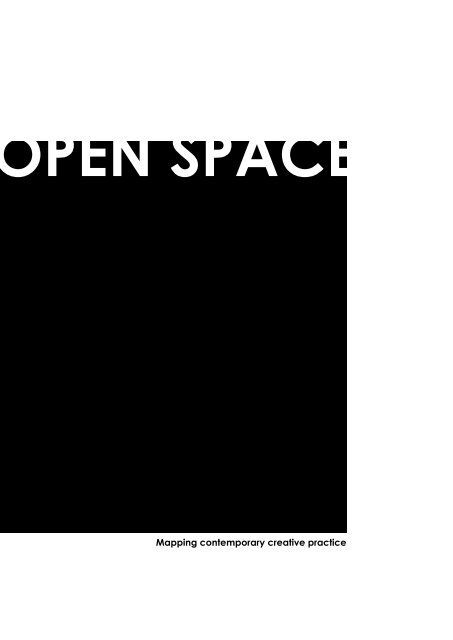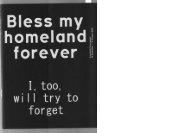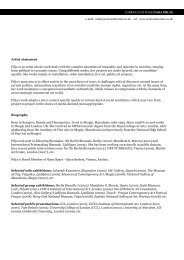Book, Mapping contemporary creative practice, 2008 ... - Nada Prlja
Book, Mapping contemporary creative practice, 2008 ... - Nada Prlja
Book, Mapping contemporary creative practice, 2008 ... - Nada Prlja
Create successful ePaper yourself
Turn your PDF publications into a flip-book with our unique Google optimized e-Paper software.
PEN SPACE<br />
<strong>Mapping</strong> <strong>contemporary</strong> <strong>creative</strong> <strong>practice</strong>
CONTENT<br />
10 SPACES OF PRODUCTION: OPEN SPACE<br />
Gülsen Bal in Conversation with Costanza Meli<br />
13 CRISIS CONFLICT OF INTERESTS<br />
Georg Schöllhammer / Hedwig Saxenhuber<br />
Translation to English by Alla Welz<br />
15 FINANCIALIZATION OF CAPITAL<br />
AND FINANCIALIZATION OF (CULTURAL)<br />
INSTITUTIONS<br />
<br />
21 SELFS-ORGANISED (AUXILIARY)<br />
SHOWROOMS - A WALK AROUND VIENNA’S<br />
“ALTERNATIVE SPACES SCENE”<br />
Christa Benzer<br />
Translation to English by Helen Ferguson<br />
26 TEMPORARY ZONES<br />
Gülsen Bal<br />
32 POST-SCRIPT TO MIGRASOPHIA:<br />
UBIQUITOUS TOPOLOGY<br />
Zeigam Azizov<br />
38 INTERFACE<br />
Juraj Carný<br />
42 INTERFATE (FACE -2- FAITH REMIX 1.0)<br />
Phoenix T. Gabriel<br />
50 ON XENOPHOBIA REDUX<br />
Anne-Britt Rage and David Rych<br />
55 EMPOWERMENT AND CLASH DER<br />
ERLKONIG VERSUS THE SUPERSOLDIER<br />
Süreyyya Evren<br />
58 WORLD-EXPO 08’<br />
<br />
64 THE EMPIRE OF SENSES - POLICE AS ART<br />
AND THE CRISIS OF REPRESENTATION<br />
Hito Steyerl<br />
70 FOLDED-IN<br />
Ilias Marmaras, Gülsen Bal and Daphne Dragona<br />
79 MATERIAL CONSCIOUSNESS<br />
Franz Thalmair<br />
Translation to English by Stefan Kirmse<br />
84 I MYSELF AM WAR!<br />
Gülsen Bal<br />
98 [I] [myself] [am] [war] [!]<br />
Susanne Lummerding<br />
Translation to English by Wilfried Prantner & Catherine<br />
Kerkhoff-Saxon<br />
102 NETWORKED CULTURES<br />
Peter Mörtenböck and Helge Mooshammer<br />
114 SPECTRAL DENSITIES IN THE<br />
NETWORKED CITIES<br />
<br />
120 STRUCTURES OF RADICALITY<br />
Walter Seidl<br />
126 MARTYRS OF POSTCULTURE UNDER<br />
EXISTENTIAL ANALYSIS<br />
Richard Appignanesi<br />
140 CONTRIBUTORS<br />
7
PETER MÖRTENBÖCK AND HELGE MOOSHAMMER,<br />
VISITING STALIN<br />
photograph<br />
TEMPORARY ZONES<br />
CURATED BY: Gülsen Bal<br />
Rethinking of identity, territory, borders = Ø location<br />
<br />
happen is if you throw the strata into demented or suicidal collapse, which brings them back down on<br />
us, heavier than ever. This is how it should be done: lodge yourself on a stratum, experiment with the<br />
<br />
1<br />
<br />
The exhibition The Temporary Zones offers a space for exploration of current relations of and in<br />
<br />
of Europe. In pointing out the space of current relations, the scope of the project The Temporary Zones<br />
<br />
temporal construct seemingly erases all its secrets and ambiguities. In a passage of an unstable world, this<br />
<br />
at the edge of building cross-border dialogues.<br />
Contact Zones<br />
Today there exists a complex relationship between an enlarging European space and neighbouring countries<br />
forming a sub-region on the south-eastern fringes of Europe. This highlights the material and symbolic uses<br />
of borders.<br />
Despite the certainty of function, the meaning of borders has been uncertain and contradictory; this<br />
situation has been further compounded by the force of globalization and change on territory within the<br />
paradox of both undermining and reinstating a territorial logic of governance. This ambiguity and dynamics<br />
has resulted in ‘border change’ that not only transform existing border but also change the material<br />
functions and symbolic meanings of borders. For that reason, the ‘new’ border are no longer territorial lines,<br />
but instead designates location in mobility, points of arrivals/departures transcending nation-state and its<br />
<br />
Still, “pragmatics and micropolitics constitute themselves in nomadology… constituted into geology<br />
of action.” Conversely, the idea of a European cultural space is also about symbolic boundaries between<br />
‘us’ and ‘them’ where representations of Europe become part of the imaginary. In contrast to the present<br />
<br />
importance of imaginary reconstruction. This problematises the possibility that what is real is that which<br />
used to exist and its transformative potential in the subject (the loss of the “specular I of the Imaginary”)<br />
and between subjects (the entry into the “social I of the Symbolic”).<br />
This is conceived within representational boundaries in the immediacy: “here and now” that is inhabited.<br />
26 27
This occurs from within disparities and a tension that a node traverses its initial position to its transition<br />
of which has taken place. Still a shift occurs where the critical models are designated at the junction<br />
of temporal relations.<br />
The orientation of this inference reveals itself in “the <strong>practice</strong>s of representation as implicate [...] the position<br />
of enunciation”. 2 structures affected by a transitory characteristic, the “in-between-ness”. An uncertain transition, as it<br />
appears in The Rights, provokes an encounter with a situation to a norm extrinsic to that situation at the edge<br />
of a certain representational matrix while dramatically capturing the moment that mirrors the “other” of<br />
Europe by way of its multitude of particular identities.<br />
This governs a political thinking that is aware of its own strategy and contingency in all its<br />
In their work, Peter Mörtenböck and Helge Mooshammer<br />
heterogeneity or diversity and it engenders itself through multiple connections by mapping both psychical<br />
<strong>contemporary</strong> world through exploring the potentials and effects of networked spatial <strong>practice</strong>s.<br />
and the social locations when engaged in multiple networks of production exits within dialogical process<br />
<br />
generating contact zones.<br />
knowledge embodied by these new forms of socio-spatial organisation and group action. In doing so, they<br />
Tracing an imaginary line along the emerging borders and across a map of the European space within the<br />
raise questions how the emergence of networked cultures has changed our cultural forms of cohabitation<br />
logic of mobility that supports the current political construction and politicisation of life, each participating<br />
and communication, and how we produce and experience the spaces we live in vis-à-vis a globalised<br />
artist in The Temporary Zones creates works that respond in particular ways, to take a deeper look<br />
<br />
at complex relational powers, with a new conjunction of transitions in a designated quasi -accessible space<br />
The text-supported photo story Visiting Stalin assembles the visual signs and symbols of cultural<br />
that resides in space/place making within the <strong>creative</strong> <strong>practice</strong>.<br />
hybridisations and economic superimpositions in a global city like Moscow. This follows the myriad stories<br />
<br />
is known for his lyrical and unsettling video installations that reconstitute our sense<br />
and histories around the site of the former Stalinets Stadium in Moscow-Izmailovo that today forms the<br />
of space, and pose questions about our understanding of place and identity in a globalised society<br />
empty inner zone of the sprawling Cherkizovsky Market. Three times the size of the Moscow Kremlin, the<br />
marked by mobility.<br />
market supports Russia’s new millionaires as well as thousands of migrants from Tajikistan, Uzbekistan,<br />
His recent single channel video Empire (after Andy Warhol) reframes an ordinary building in reference to the<br />
and China and extended Southeast Asia, who has come to seek work as stall-minders, carriers and tea-<br />
representation of an iconicized structure, while shifting from the global to the local. Borrowing his title<br />
sellers. The project explores how markets function as a dynamic force that generates new forms of collective<br />
<br />
exchange, and how this process relates to the aesthetics of establishing new social orders.<br />
8 hours and 6 minutes and chronicles the passage from day to night, Although these experimental structures are highly unstable, they leave their mark on the fabric of the city.<br />
of current relations’ associated with notions of temporal and spatial continuity.<br />
They transport images, ideas and values between different worlds. And with their improvised technologies,<br />
Empire (after Andy Warhol) captures the transition from day to night surrounding a residential apartment<br />
infrastructures and spatial policies, they create openings for new urban situations and new links between the<br />
block in a static shot, thus reframing the existing strangeness of a minaret rising through the roof of the<br />
local and the global levels.<br />
<br />
and the main part of the mosque with the prayer room for worshipping is situated in the basement of<br />
the apartment. Illuminating light abruptly goes dark, generating a different register through a moment<br />
of interruption where we witness something different, ‘another truth’ in which the concepts of domestic<br />
Notes:<br />
comfort are unsettled through an unrelenting gaze.<br />
1. Deleuze, G. and Guattari, F. Brian Massumi (Translation). A Thousand Plateaus. London: The<br />
Athlone Press, 1988, p. 161<br />
‘THE RIGHTS, I AM MACEDONIAN’, ‘THE RIGHTS,<br />
2. Hall, S. “Cultural Identity and Cinematic Representation” in Exiles: Essays on Caribbean Cinema.<br />
I AM ROMANIAN’, ‘THE RIGHTS, I AM TURKISH’,<br />
Edited by Mbye Cham, New Jersey: African World Press, 1992, p.230<br />
‘THE RIGHTS, I AM SERBIAN’, etc.<br />
The Rights is a series of video recordings of children who are reading ‘European Convention for the<br />
January 10th – February 9th, <strong>2008</strong><br />
Protection of Human Rights and Fundamental Freedom’ in the manner it presents that there is no<br />
protection of human rights and freedom. In this work, <strong>Nada</strong> <strong>Prlja</strong> exposes the complexity of the issues<br />
Please refer to:<br />
of immigration and the EU politics around the boundaries of ‘New Europe’.<br />
http://www.ergincavusoglu.com<br />
<strong>Prlja</strong><br />
http://www.seriousinterests.co.uk<br />
<br />
The Rights engenders the potentiality in<br />
http://www.networkedcultures.org<br />
the course of absorbing the results of its transformative capacities where the cultural objects are produced<br />
within a paradigm of introducing everyday settings. This inquiry puts across a disjointed temporality which<br />
exposes the ambiguity of the situation. Thus the issue introduced here refers to an experimental dynamic<br />
<br />
construction encapsulated in the midst of “who speaks”.<br />
The space of current relations brings us to draw an attention to a generative process of differential<br />
28 29
NADA PRLJA,<br />
THE RIGHTS<br />
video still<br />
right:<br />
NADA PRLJA,<br />
THE RIGHTS<br />
installation view<br />
<br />
EMPIRE (AFTER ANDY WARHOL)<br />
video still<br />
30 31






